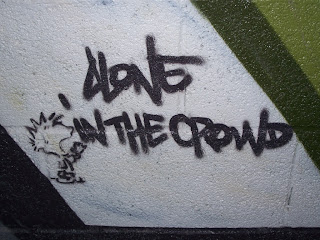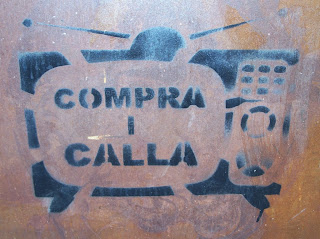Of all of the places that exist and are completely unknown to Americans (but found by the British and so already reasonably anglophone),
Tarragona has to take the cake. Tarragona has great Roman ruins, and as Herculaneum was quite possibly the single most exciting thing I did last summer, the ruins of Tarragona were another triumph of the resilience, survival power and class of Roman arts and architecture.
For example, before we got there, I had
no idea that Tarragona was the capital of most of Iberia during the Roman period:
Hispania Tarraconensis. That's kind of a big deal, because Hispania is where the
"civilized" Romans came from (see also
Gladiator).

When we got there on Wednesday afternoon, I mostly slept. I also mostly slept on the hour-long, 100km train ride south. When I woke up, it was time to get off, so I got my suitcase off of the rack and started getting ready to get off the train. As I was on my way out of the car, a woman informed me in perfect
Català that
Kennywood was open.
Our hotel was the Hotel Husa Imperial Tarraco, which was affordable only because we were traveling during the off-season. This trip confirmed for me that early March really is the time to travel -- few tourists, great Mediterranean weather, and affordable beyond belief.
 The big modern building was our hotel -- Mediterranean view. Right along the water next to the Roman circus and ampitheatre. The only drawback is that the walk to the beach was kind of down the side of a cliff of sorts, and across train tracks. Tarragona's tagline is "Balcony of the Mediterranean," which is pretty accurate -- everything is well above the sea.
The big modern building was our hotel -- Mediterranean view. Right along the water next to the Roman circus and ampitheatre. The only drawback is that the walk to the beach was kind of down the side of a cliff of sorts, and across train tracks. Tarragona's tagline is "Balcony of the Mediterranean," which is pretty accurate -- everything is well above the sea. The picture above illustrates how much of the Roman circus was taken into later buildings. The middle house is the exact width of the gallery of the Roman circus. A guide at the site also told us that the ATM in one of the banks is also part of the circus... Amazing.
The picture above illustrates how much of the Roman circus was taken into later buildings. The middle house is the exact width of the gallery of the Roman circus. A guide at the site also told us that the ATM in one of the banks is also part of the circus... Amazing.
 This picture further illustrates the Roman foundations of a lot of Tarragona
This picture further illustrates the Roman foundations of a lot of Tarragona-- like, "hi, my basement is Roman."
 I was kind of suprised to see this photo, which documents the visit to Tarragona by Count Galeazzo Ciano, who, if such a thing is possible, is my favorite fascist (it's not really possible). He, besides being Mussolini's son-in-law and one of the first to suggest to the Fascist Council that they take the side of the Allies, also fathered an aborted child of Wallis Simpson in Shanghai in the early 30s. Overall, I think he was much smarter than Mussolini (and Hitler), and he found himself in the wrong place at the wrong time. Perhaps if had he survived the war he probably could have resurrected his reputation a bit because he was a pretty intelligent statesman -- though his personal reputation as a playboy would have caused trouble, so he maybe would have ended up like the Savoia. Hah.
I was kind of suprised to see this photo, which documents the visit to Tarragona by Count Galeazzo Ciano, who, if such a thing is possible, is my favorite fascist (it's not really possible). He, besides being Mussolini's son-in-law and one of the first to suggest to the Fascist Council that they take the side of the Allies, also fathered an aborted child of Wallis Simpson in Shanghai in the early 30s. Overall, I think he was much smarter than Mussolini (and Hitler), and he found himself in the wrong place at the wrong time. Perhaps if had he survived the war he probably could have resurrected his reputation a bit because he was a pretty intelligent statesman -- though his personal reputation as a playboy would have caused trouble, so he maybe would have ended up like the Savoia. Hah. This was actually nothing during the Roman period.
This was actually nothing during the Roman period.It was a subterranean gallery then, as it is now, and mostly provided support for the bleachers above.
However, it is like 90 meters long or something like that, which makes it unbelievable.
 Here I am between the Roman archeological sites and the archeological museum, which is to the left. Mum said I finally started to smile here, which is true to the extent that I really felt relaxed and on vacation at Tarragona -- in Barcelona I was still wound up from being busy at school. Plus, who can not smile with the Mediterranean in the background? And gorgeous, bright sun.
Here I am between the Roman archeological sites and the archeological museum, which is to the left. Mum said I finally started to smile here, which is true to the extent that I really felt relaxed and on vacation at Tarragona -- in Barcelona I was still wound up from being busy at school. Plus, who can not smile with the Mediterranean in the background? And gorgeous, bright sun.
 This little bronze was spectacular. The Romans (although I'm not sure exactly where this came from, it could have been imported from Greece, knowing the Romans) knew what they were doing with bronzes.
This little bronze was spectacular. The Romans (although I'm not sure exactly where this came from, it could have been imported from Greece, knowing the Romans) knew what they were doing with bronzes.
So delicate. 

 I thought these urns (more like ossuaries maybe) were so cool, because the bones were still inside them!
I thought these urns (more like ossuaries maybe) were so cool, because the bones were still inside them!The lower one is made of glass.
 I like peacocks, mostly because they are the most sophisticated symbol of eternal life.
I like peacocks, mostly because they are the most sophisticated symbol of eternal life. The sculpting on this was so delicate as well -- look at the teeth.
The sculpting on this was so delicate as well -- look at the teeth. I had been biking along the inner harbor, and all of a sudden,
I had been biking along the inner harbor, and all of a sudden, Along the Passeig de Lluís Companys. I think, although I could be wrong, that these street lamps were designed by a young Gaudí.
Along the Passeig de Lluís Companys. I think, although I could be wrong, that these street lamps were designed by a young Gaudí. 















































